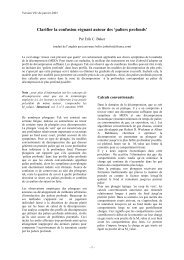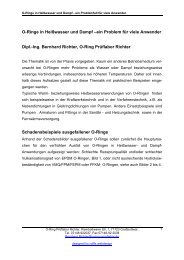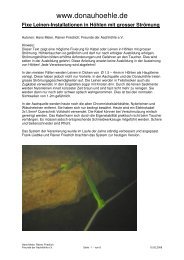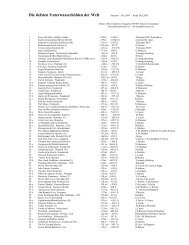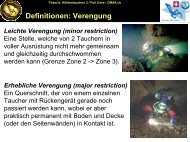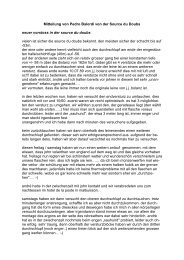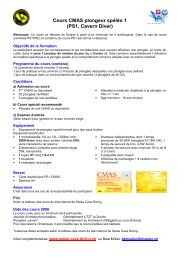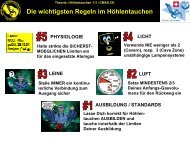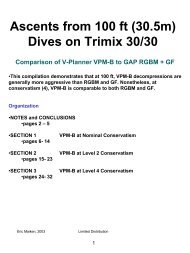cave diving and the nss - bei Swiss-Cave-Diving
cave diving and the nss - bei Swiss-Cave-Diving
cave diving and the nss - bei Swiss-Cave-Diving
You also want an ePaper? Increase the reach of your titles
YUMPU automatically turns print PDFs into web optimized ePapers that Google loves.
40 CAVE DIVING COMMUNICATIONS REELS AND LINE MARKERS 41<br />
Arrow <strong>bei</strong>ng "clipped" into line<br />
Clipping will attach it to line temporarily.<br />
Arrow <strong>bei</strong>ng "looped" into line<br />
for fur<strong>the</strong>r security<br />
If in doubt about <strong>the</strong> security of <strong>the</strong> arrow, make <strong>the</strong> extra wrap.<br />
End product of "clipping" versus "looping"<br />
you pass is pointing in <strong>the</strong> correct direction. If you encounter a line<br />
arrow which seems amiss, confirm your location <strong>and</strong> direction of<br />
travel. Backtrack your known direction of travel <strong>and</strong> check arrows<br />
along that route. If in doubt, call <strong>the</strong> dive. You do know from which<br />
direction you entered <strong>the</strong> <strong>cave</strong>, don't you? It is far better to return<br />
ano<strong>the</strong>r day, after consulting with o<strong>the</strong>rs more familiar with <strong>the</strong> <strong>cave</strong><br />
system, than to press on <strong>and</strong> invite trouble.<br />
In more popular systems, plastic line arrows are placed every<br />
100 to 150 feet apart. Arrows are also generally placed at potential<br />
"jump" points to secondary passageways, <strong>the</strong> beginning <strong>and</strong> end<br />
of permanent lines, or anywhere else directional decisions need to<br />
be reinforced.<br />
In order to be confident that <strong>the</strong> plastic line arrow is properly<br />
secured <strong>and</strong> not likely to be moved about by current or a careless<br />
diver, <strong>the</strong> arrow should be looped into <strong>the</strong> guideline. If <strong>the</strong> line<br />
arrow is intended to be temporary (i.e., you are planning to remove<br />
it on your way out), it is completely acceptable to simply clip <strong>the</strong><br />
arrow onto <strong>the</strong> guideline. If in doubt about <strong>the</strong> arrow <strong>bei</strong>ng moved<br />
about, <strong>the</strong>n by all means, install it with a loop. It is as easy to install<br />
<strong>the</strong> arrow one way as it is <strong>the</strong> o<strong>the</strong>r.<br />
Any device installed on a guideline, permanent or temporary,<br />
should be identified as belonging to <strong>the</strong> installer, although it is true<br />
that some relining projects at major sites do not take <strong>the</strong> time to<br />
identify each arrow. The marking of <strong>the</strong> arrows is as simple as<br />
writing your initials on <strong>the</strong> arrow with indelible ink. The purpose of<br />
this identification process is to provide a secondary confirmation of<br />
a marker. Seeing your own markers, or those of a known individual<br />
or group, pointing toward a known exit can be very comforting in<br />
an o<strong>the</strong>rwise uneasy situation.<br />
CLOTHESPINS<br />
Clo<strong>the</strong>spins are generally considered temporary line markers<br />
<strong>and</strong> can be used in a variety of ways. For example, dive teams<br />
will often use clo<strong>the</strong>spins to indicate <strong>the</strong> maximum penetration into<br />
a <strong>cave</strong> passage during initial exploration by that team. O<strong>the</strong>rs use<br />
clo<strong>the</strong>spins to identify prior penetration points when setting up a<br />
traverse (entering at one location <strong>and</strong> exiting at ano<strong>the</strong>r). Clo<strong>the</strong>spins<br />
are also used to confirm an original exit direction when jumping<br />
from one line to ano<strong>the</strong>r, or <strong>the</strong>y can be used to indicate that more




